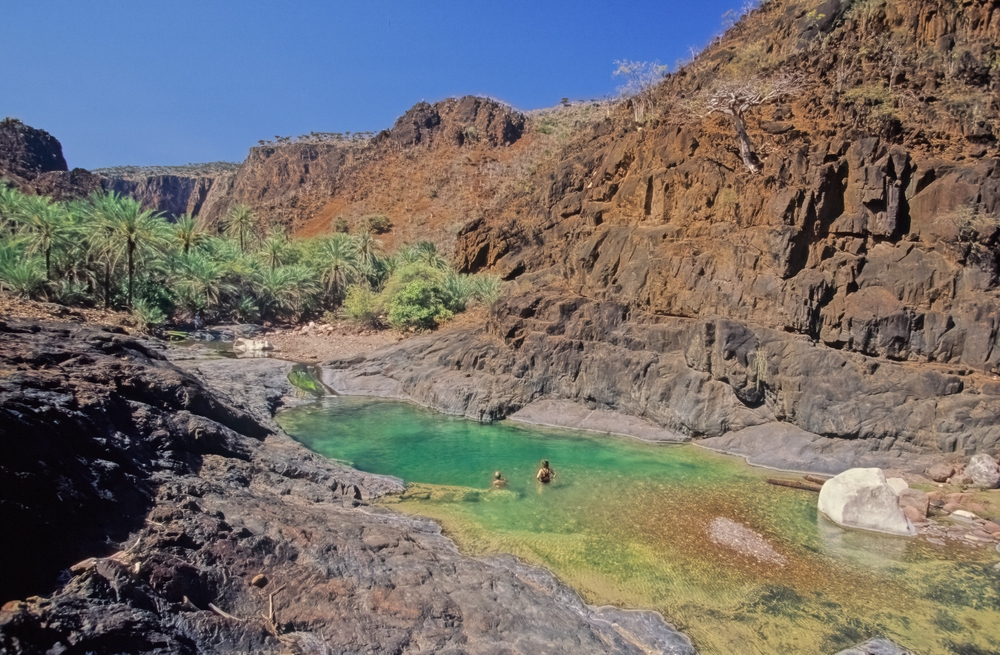Socotra Overview
Socotra National Park, located in Yemen, is a stunning and ecologically unique protected area that covers approximately 1,466 square miles (3,800 square kilometers) of the Socotra Archipelago.
Situated in the Arabian Sea, about 240 miles (380 kilometers) off the coast of mainland Yemen, the park is a sanctuary for some of the world’s most unusual and endemic flora and fauna. Socotra’s isolation over millions of years has resulted in the evolution of an extraordinary landscape, featuring bizarre and ancient plant life that is found nowhere else on Earth.
Its rugged terrain includes limestone plateaus, deep canyons, towering cliffs, and striking coastal dunes, all contributing to the dramatic scenery that makes this park one of the most visually unique in the world.
The park’s landscape is dominated by dramatic limestone formations and granite mountains, with the Haggeher Mountains reaching elevations of over 5,000 feet (1,500 meters). These rugged highlands gradually transition into vast plateaus covered in rare vegetation, while the coastline is fringed with white sand beaches and jagged limestone caves.
The arid climate, coupled with seasonal monsoons, has led to the evolution of plants that are exceptionally well adapted to harsh conditions. One of the most iconic species is the Dragon’s Blood Tree (Dracaena cinnabari), with its umbrella-like canopy and deep red resin, which has been valued for its medicinal and dyeing properties for centuries. The Desert Rose (Adenium obesum socotranum) is another striking feature of the landscape, with its thick, bottle-shaped trunk that stores water in the island’s dry conditions.
Socotra National Park is home to a wealth of unique wildlife, including numerous species that exist nowhere else on Earth. It is a haven for bird enthusiasts, with over 200 species recorded, including the Socotra Starling, Socotra Sunbird, and the rare Egyptian Vulture, which soars over the rugged cliffs and coastal plains.
The island’s reptile population is particularly notable, with an array of geckos, skinks, and snakes that have adapted to the park’s varying habitats. While there are no large land mammals, the surrounding waters teem with marine life, including dolphins, sea turtles, and a diverse range of fish species that thrive in the coral reefs. The park is also home to several caves, which shelter endemic bat species that contribute to the island’s fragile ecosystem.
One of the most popular features of Socotra National Park is its breathtaking landscapes, which draw adventurers and nature lovers alike. Visitors can explore the mysterious caves of Hoq, home to ancient stalactites and rock carvings, or trek through the remote canyons of Wadi Dirhur, where lush vegetation contrasts with towering cliffs.
The park’s beaches, such as Qalansiyah and Shoab, offer pristine shorelines and crystal-clear waters ideal for snorkeling and diving, revealing vibrant coral reefs and an abundance of marine life. The stunning sand dunes of Arher, where freshwater springs emerge from beneath towering dunes, provide an awe-inspiring view of the island’s geological contrasts.
Visitors to the park can experience its beauty through guided trekking expeditions that traverse the rugged mountains and plateaus, providing breathtaking views of the island’s diverse landscapes. Camping under the clear night skies offers a chance to witness the stars in one of the world’s most unpolluted atmospheres.
Birdwatching is another favorite activity, as the park’s endemic avian species provide endless opportunities for wildlife enthusiasts. For those interested in the marine environment, diving and snorkeling excursions allow visitors to discover the vibrant underwater ecosystems that surround the island. Socotra’s cultural heritage is also a highlight, with interactions with the local Bedouin communities offering insight into the island’s traditional way of life.
Socotra National Park faces significant conservation challenges due to its fragile ecosystems and increasing human pressures. The impact of climate change, overgrazing by livestock, and unregulated tourism pose threats to its biodiversity.
However, conservation efforts have been made to protect its unique environment, with UNESCO designating the Socotra Archipelago as a World Heritage Site in recognition of its unparalleled ecological importance.
Efforts to regulate tourism, implement sustainable development projects, and involve local communities in conservation initiatives have shown promise in preserving the park’s exceptional natural heritage.










































































